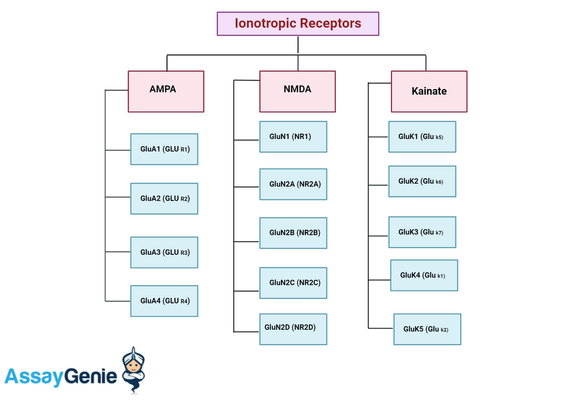Ionotropic Glutamate Receptors: Gateways to Neural Communication
Ionotropic glutamate receptors (iGluRs) are pivotal in the fast excitatory synaptic transmission in the mammalian central nervous system (CNS). These receptors are not only crucial for normal brain function, including learning and memory but are also implicated in various neurological disorders, making them a significant subject of neuropharmacological research.
The Basics of Glutamate and Its Receptors:
Glutamate is the primary excitatory neurotransmitter in the CNS. It exerts its effects through two main types of receptors: ionotropic and metabotropic glutamate receptors. Ionotropic receptors are ligand-gated ion channels, which, upon binding of glutamate, open to allow the flow of ions such as Na+, K+, and sometimes Ca2+ across the cell membrane, leading to neuronal depolarization.
Classification of Ionotropic Glutamate Receptors
Ionotropic glutamate receptors are categorized into three major types based on their agonist specificity and sequence similarity: N-methyl-D-aspartate (NMDA) receptors, α-amino-3-hydroxy-5-methyl-4-isoxazolepropionic acid (AMPA) receptors, and kainate receptors. Each type plays a unique role in synaptic transmission and plasticity.
- NMDA Receptors
NMDA receptors are known for their high Ca2+ permeability and voltage-dependent magnesium block, making them critical for synaptic plasticity, a cellular mechanism underlying learning and memory. They are composed of several subunits, typically NR1, NR2 (A-D), and NR3 (A-B), which determine their pharmacological properties and distribution within the brain.
- AMPA Receptors
AMPA receptors mediate fast synaptic transmission throughout the CNS. They are composed of four types of subunits, GluA1-4, and their assembly into tetramers determines the functional properties of the receptor, such as ion conductance and desensitization kinetics. AMPA receptors are critical for synaptic plasticity, particularly in the form of long-term potentiation (LTP).
- Kainate Receptors
Kainate receptors, composed of GluK1-5 subunits, are involved in both pre- and postsynaptic signaling. Though less understood than NMDA and AMPA receptors, kainate receptors modulate neurotransmitter release, synaptic transmission, and plasticity, contributing to the fine-tuning of neural circuits.
Mechanisms of Action
Upon glutamate binding, iGluRs undergo conformational changes that lead to the opening of their ion channels. This ion flow can depolarize the postsynaptic neuron, potentially triggering an action potential if the depolarization is sufficient. This process is fundamental to the transmission of excitatory signals across synapses.
Physiological Roles and Clinical Implications
Ionotropic glutamate receptors are involved in nearly every aspect of brain function, including cognitive processes like learning and memory. Dysregulation of glutamate signaling, however, is linked to numerous neurological disorders, such as epilepsy, ischemic stroke, and neurodegenerative diseases like Alzheimer's disease and Huntington's disease. This association underlines the importance of iGluRs as therapeutic targets.
Therapeutic Targets and Research Directions
Given their central role in CNS function and pathology, iGluRs are attractive targets for therapeutic intervention. NMDA receptor antagonists, for example, have been explored for their neuroprotective properties in stroke and traumatic brain injury, while AMPA receptor modulators are investigated for their potential in treating psychiatric disorders and cognitive enhancement.
Challenges and Future Directions
Despite the therapeutic potential, targeting iGluRs poses significant challenges. The widespread and essential role of glutamate signaling in the CNS means that modulation of these receptors must be precisely controlled to avoid disrupting normal brain function. Furthermore, the development of subtype-selective ligands is crucial for minimizing side effects.
As research advances, a more detailed understanding of iGluRs' structure, function, and role in disease is emerging. This knowledge is crucial for the development of novel therapeutic strategies that harness the potential of iGluRs to treat neurological disorders while minimizing adverse effects.
Conclusion
Ionotropic glutamate receptors are fundamental to neural communication, playing crucial roles in both normal brain function and disease. As research progresses, targeting these receptors with increasing precision offers hope for new treatments for a range of neurological conditions, marking an exciting frontier in neuropharmacology and neuroscience.
References
- Traynelis, S.F., Wollmuth, L.P., McBain, C.J., et al. (2010) 'Glutamate receptor ion channels: structure, regulation, and function', Pharmacological Reviews, 62(3), pp. 405-496.
- Dingledine, R., Borges, K., Bowie, D., and Traynelis, S.F. (1999) 'The glutamate receptor ion channels', Pharmacological Reviews, 51(1), pp. 7-61. Available at: [Publisher's site].
- Paoletti, P., Bellone, C., and Zhou, Q. (2013) 'NMDA receptor subunit diversity: impact on receptor properties, synaptic plasticity and disease', Nature Reviews Neuroscience, 14(6), pp. 383-400.
- Collingridge, G.L., Olsen, R.W., Peters, J., and Spedding, M. (2009) 'A nomenclature for ligand-gated ion channels', Neuropharmacology, 56(1), pp. 2-5.
- Henley, J.M., and Wilkinson, K.A. (2016) 'AMPAR auxiliary proteins: the orchestra conducting synaptic strength', Biochemical Society Transactions, 44(2), pp. 569-580.
- Bowie, D. (2012) 'Ionotropic glutamate receptors & CNS disorders', CNS & Neurological Disorders Drug Targets, 11(5), pp. 608-618.
- Lynch, D.R., and Guttmann, R.P. (2002) 'Excitatory amino acids as a final common pathway for neurologic disorders', The New England Journal of Medicine, 347(14), pp. 1113-1123.
- Mayer, M.L. (2011) 'Structure and mechanism of glutamate receptor ion channel assembly, activation, and modulation', Current Opinion in Neurobiology, 21(2), pp. 283-290.
Written by Tehreem Ali
Tehreem Ali completed her MS in Bioinformatics and conducted her research work at the IOMM lab at GCUF, Pakistan.
Recent Posts
-
Metabolic Exhaustion: How Mitochondrial Dysfunction Sabotages CAR-T Cell Therapy in Solid Tumors
Imagine engineering a patient's own immune cells into precision-guided missiles against cancer—cells …8th Dec 2025 -
The Powerhouse of Immunity: How Mitochondrial Fitness Fuels the Fight Against Cancer
Why do powerful cancer immunotherapies work wonders for some patients but fail for others? The answe …5th Dec 2025 -
How Cancer Cells Hijack Immune Defenses Through Mitochondrial Transfer
Imagine a battlefield where the enemy doesn't just hide from soldiers—it actively sabotages their we …5th Dec 2025




